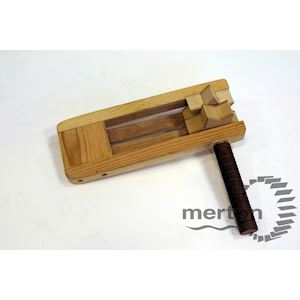
Replica (gas) football rattle
Early versions of this rattle or ratchet are said to have existed since Biblical times, when it was a type of musical instrument. The rattle consists of a gearwheel and small stiff pieces of wood linked to a handle. Swinging the handle moves the rattle head round, forcing the wood against the gearwheel, creating a series of clicks or rattling sounds. The faster the rotation, the louder the noise. In 17th century America, a group known as the Rattle Watch patrolled settlements at night and used their rattles to warn farmers and fellow colonists of danger. In 18th century London, early policemen or “Peelers” used rattles to summon assistance. Rattles were also used in the First World War trenches to warn of poison gas attacks and by Air Raid wardens to warn the public of impending raids and the possible threat of gas attack during World War II. Between the 1940s and 1960s wooden rattles were a common sight and sound at British football matches, including those held at the Plough Lane stadium of Wimbledon Football Club and the Sandy Lane terraces of Tooting & Mitcham F C. Fans would wave their rattles enthusiastically, sing team anthems and chants, creating a wall of sound designed to cheer on the home team and silence their opponents. Rattles were eventually banned during the 1970s, to prevent them from being used as weapons by football hooligans – however by this stage they were already falling out of fashion.


Merton Heritage and Local Studies Centre
The Merton Heritage and Local Studies Centre tells the story of Merton and its people through a changing programme of exhibitions and events. This audio guide is part of a range of activities and support for local adult residents living with special needs, including autism, visual impairment and hearing loss. This project will help make Merton’s local heritage more accessible to visitors with a range of needs. Please refer to our website for opening hours.
- Merton Heritage Local Studies Centre
- London United Kingdom
- 020 8545 3239/4038
- libraries.merton.gov.uk/client/en_gb/
